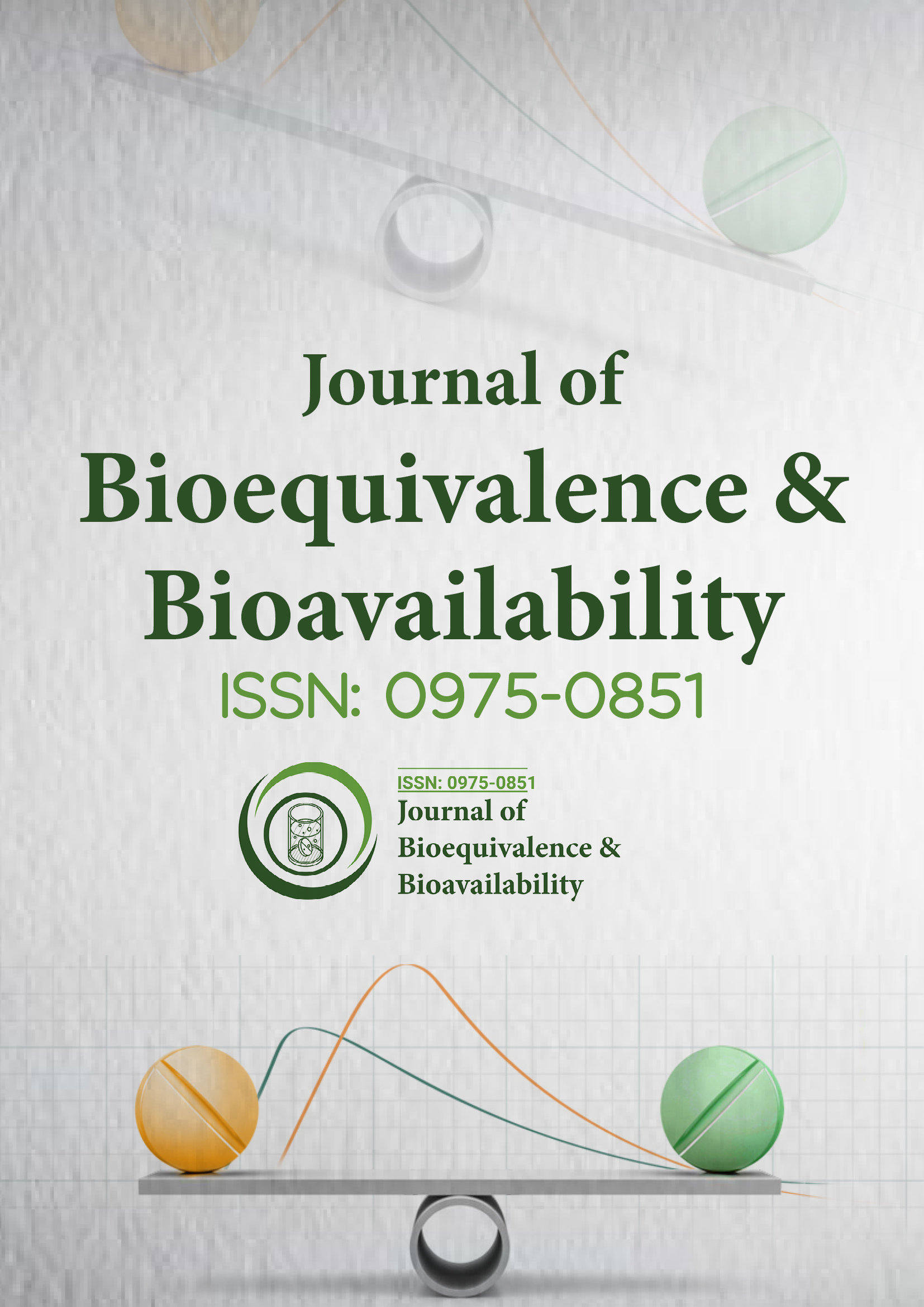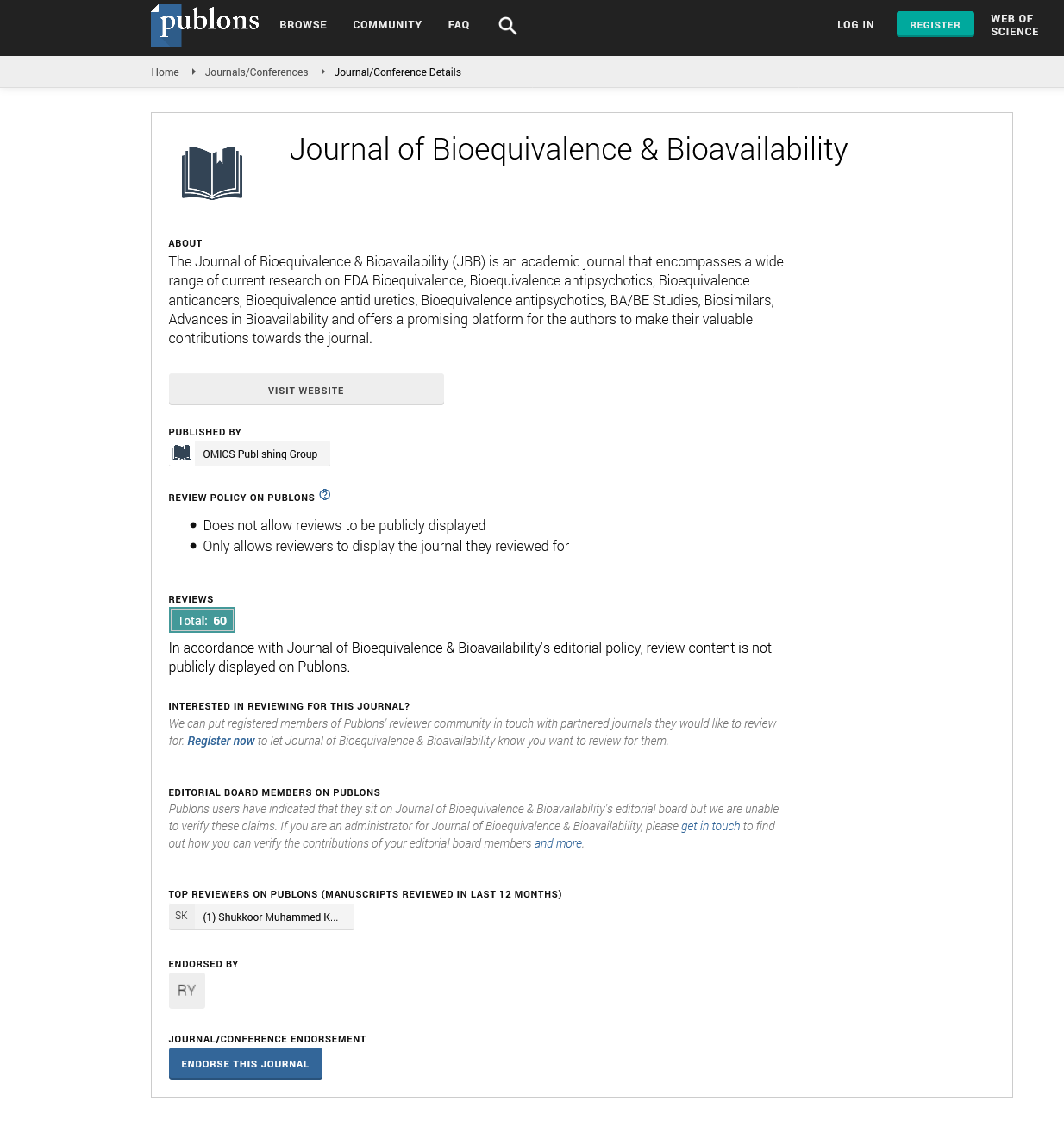Indexed In
- Academic Journals Database
- Open J Gate
- Genamics JournalSeek
- Academic Keys
- JournalTOCs
- China National Knowledge Infrastructure (CNKI)
- CiteFactor
- Scimago
- Ulrich's Periodicals Directory
- Electronic Journals Library
- RefSeek
- Hamdard University
- EBSCO A-Z
- OCLC- WorldCat
- SWB online catalog
- Virtual Library of Biology (vifabio)
- Publons
- MIAR
- University Grants Commission
- Geneva Foundation for Medical Education and Research
- Euro Pub
- Google Scholar
Useful Links
Share This Page
Journal Flyer

Open Access Journals
- Agri and Aquaculture
- Biochemistry
- Bioinformatics & Systems Biology
- Business & Management
- Chemistry
- Clinical Sciences
- Engineering
- Food & Nutrition
- General Science
- Genetics & Molecular Biology
- Immunology & Microbiology
- Medical Sciences
- Neuroscience & Psychology
- Nursing & Health Care
- Pharmaceutical Sciences
Perspective - (2025) Volume 17, Issue 2
Pharmacokinetic Parameters in Anvisaâs Bioequivalence Studies: Ensuring Therapeutic Equivalence of Generics
Ebony Jens*Received: 03-Apr-2025, Manuscript No. JBB-24-28976; Editor assigned: 07-Apr-2025, Pre QC No. JBB-24-28976 (PQ); Reviewed: 21-Apr-2025, QC No. JBB-24-28976; Revised: 28-Apr-2025, Manuscript No. JBB-24-28976 (R); Published: 05-May-2025, DOI: 10.35248/0975-0851.25.17.628
Description
Bioequivalence is a foundational concept in the regulation of generic drugs, ensuring that a generic product performs in the same manner as its branded counterpart. In Brazil, this regulatory oversight is conducted by the Agencia Nacional de Vigilancia Sanitaria (Anvisa), the country’s health regulatory agency. Over the past two decades, Anvisa has significantly advanced the rigor and transparency of its bioequivalence requirements, establishing itself as a key player in the global pharmaceutical regulatory landscape.
Anvisa's approach to bioequivalence is rooted in the principle that the safety and efficacy of generic drugs must be equivalent to those of innovator products. To this end, it mandates that generics must demonstrate bioequivalence through rigorous pharmacokinetic studies. These studies measure parameters such as the Area Under the concentration-time Curve (AUC) and the maximum concentration (Cmax) to ensure that the rate and extent of absorption fall.
One of Anvisa's major contributions has been the establishment of the National Network of Bioavailability and Bioequivalence Centers (Rede Cebio), which standardizes procedures and ensures high-quality data across certified laboratories. This initiative has not only built national capacity but also fostered public-private collaboration in the development of robust testing infrastructure.
In addition to conventional pharmacokinetic studies, Anvisa recognizes biowaivers under certain conditions. For drugs classified as BCS Class I or III, in vitro dissolution testing may be used to infer bioequivalence, provided that the product meets stringent criteria. This streamlined process reduces the need for human studies, expediting the approval of generics and ultimately improving access to affordable medicines.
A notable strength of Anvisa's regulatory framework is its adaptability to emerging technologies. As pharmaceutical innovation advances, so too does Anvisa’s responsiveness to novel delivery systems and complex generics. For instance, bioequivalence requirements have been tailored to accommodate controlled-release formulations, transdermal systems, and biological products. Anvisa’s guidance also reflects an awareness of global regulatory harmonization, drawing upon standards established by the WHO, FDA, and EMA.
Despite these advances, the bioequivalence regulatory environment in Brazil faces ongoing challenges. One key issue is the variability in data quality and consistency across testing centers, despite the existence of centralized standards. Anvisa has responded by increasing inspections, investing in training programs, and implementing electronic data monitoring to enhance oversight.
Another concern is the regulatory backlog. As the number of drug applications grows, Anvisa has been pressured to streamline its review process without compromising scientific rigor. Recent digitization efforts, such as the adoption of electronic submission portals and risk-based review models, aim to address this challenge.
Moreover, Anvisa's bioequivalence policy is increasingly intertwined with broader public health goals. By ensuring timely and reliable access to high-quality generics, the agency supports national efforts to reduce pharmaceutical expenditures and expand healthcare coverage. This is especially critical in Brazil’s public health system, where cost-effective drug procurement is essential for sustainability.
International collaboration is another area where Anvisa has made substantial strides. It participates in various harmonization initiatives, including the International Council for Harmonisation (ICH) and the Pan American Network for Drug Regulatory Harmonization (PANDRH). These engagements promote the convergence of regulatory standards, facilitating cross-border trade and mutual recognition of bioequivalence data.
Looking ahead, Anvisa is poised to expand its focus on complex generics and biosimilars, where demonstrating bioequivalence becomes more nuanced. For example, with monoclonal antibodies and other biologics, traditional pharmacokinetic endpoints may be insufficient, necessitating immunogenicity studies and advanced analytical techniques. Anvisa’s readiness to update its guidance in response to such complexities will be critical to maintaining its relevance in the evolving pharmaceutical landscape.
Through a blend of scientific rigor, regulatory innovation, and public health commitment, Anvisa has shaped a bioequivalence framework that balances accessibility with assurance of therapeutic equivalence. As Brazil continues to emerge as a regional pharmaceutical hub, Anvisa’s role in setting bioequivalence standards will remain central to fostering trust in generics and enabling equitable healthcare outcomes.
Citation: Jens E (2025). Pharmacokinetic Parameters in Anvisa’s Bioequivalence Studies: Ensuring Therapeutic Equivalence of Generics. J Bioequiv Availab. 17:628.
Copyright: © 2025 Jens E. This is an open-access article distributed under the terms of the Creative Commons Attribution License, which permits unrestricted use, distribution, and reproduction in any medium, provided the original author and source are credited.

